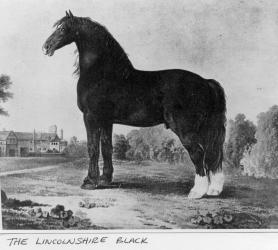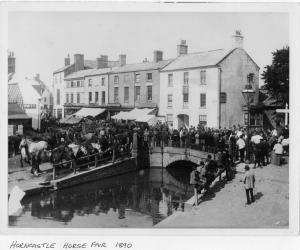
HORNCASTLE HORSE FAIR
Known as the Great August Horse Fair.
Charter granted in 1229 to celebrate the Feast of St Lawrence. First mention of horses in 1664 and to be held before the 10th August.
By at least 1306 Lincolnshire was the leading horse breeding district in the county and almost every farmer bred horses to sell at the Horncastle Fair.
The ‘Wildmore Tit’ pony was small and bred in the Fens and was used in the coal mines of Norttinghamshire and the lead mines of Derbyshire.

By the 17th Century, the ‘Lincolnshire Black’ (progenitor of the shire horse) was being bred in the Fens, generally for cart horses.
The ‘Lincolnshire Trotters’ were used for hackney carriages.
The Grand National winner of 1839 , ‘Lottery’ was bought at Horncastle Fair and buyers travelled from all over the world to purchase the best bred horses and were prepared to pay sums of between £150 and £600 even in the 18th & 19th Century. The cart horses and Trotters would fetch £25

The Fair was at its height in the mid 19th Century and ran for about two weeks. Inns with adequate stabling were required and could be accommodated at 35 inns throughout the town including the Black Horse, Reindeer, Bull & , Red Lion (favoured by foreign buyers), and after the arrival of the railway in 1855, The Great Northern. By the end of the 19th Century 1000 horses could be stabled at the inns.
In the 1800’s dealers travelled from all over the world – France, Germany, Prussia, Spain, Italy and even America to buy the best brood mares.
The fair naturally attracted much crime and ‘peppering’ was one of the favourite gambits. The inns and beer houses where the dealers relaxed at the end of the day attracted ‘pavement nymphs’ and ladies of the night.
Sunday was Show Day when large numbers of the public toured the inn yards which had been bedecked out and some horses showed their paces in the paddocks. On Sunday evening the Wesleyan Methodists organised an open air service in the Bull Ring with speakers, soloists and a harmonium on a horse dray.
With advent of the railway the fairs grew shorter and with the introduction of the motor vehicles the far gradually declined and the last one was in 1948.
The horse sculptures at the crossroads commemorate the Horse Fair and what it meant to the economy and growth of the town.
M Silverton 2020
Known as the Great August Horse Fair.
Charter granted in 1229 to celebrate the Feast of St Lawrence. First mention of horses in 1664 and to be held before the 10th August.
By at least 1306 Lincolnshire was the leading horse breeding district in the country and almost every farmer bred horses to sell at the Horncastle Fair.
The ‘Wildmore Tit’ pony was small and bred in the Fens and was used in the coal mines of Norttinghamshire and the lead mines of Derbyshire.
By the 17th Century, the ‘Lincolnshire Black’ (progenitor of the shire horse) was being bred in the Fens, generally
for cart horses.

The ‘Lincolnshire Trotters’ were used for hackney carriages.
The Grand National winner of 1839 , ‘Lottery’ was bought at Horncastle Fair and buyers travelled from all over the world to purchase the best bred horses and were prepared to pay sums of between £150 and £600 even in the 18th & 19th Century. The cart horses and Trotters would fetch £25
The Fair was at its height in the mid 19th Century and ran for about two weeks. Inns with adequate stabling were required and could be accommodated at 35 inns throughout the town including the Black Horse, Reindeer, Bull & , Red Lion(favoured by foreign buyers), and after the arrival of the railway in 1855, The Great Northern.
By the end of the 19th Century 1000 horses could be stabled at the inns.

In the 1800’s dealers travelled from all over the world – France, Germany, Prussia, Spain, Italy and even America to buy the best brood mares.
The fair naturally attracted much crime and ‘peppering’ was one of the favourite gambits. The inns and beer houses where the dealers relaxed at the end of the day attracted ‘pavement nymphs’ and ladies of the night.
Sunday was Show Day when large numbers of the public toured the inn yards which had been bedecked out and some horses showed their paces in the paddocks. On Sunday evening the Wesleyan Methodists organised an open air service in the Bull Ring with speakers, soloists and a harmonium on a horse dray.
With the advent of the railway the fairs grew shorter and with the introduction of the motor vehicles the fair gradually declined and the last one was in 1948.
The horse sculptures at the crossroads commemorate the Horse Fair and what it meant to the economy and growth of the town.
More information about the horse fair is available in the HHHS archives.
This page is currently being updated with new content.